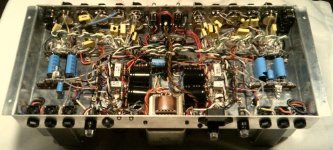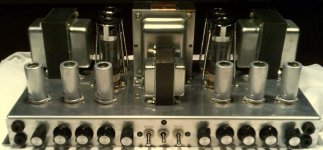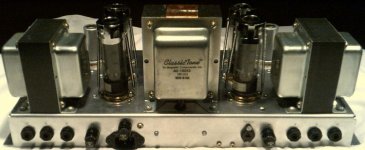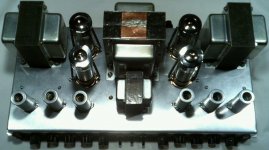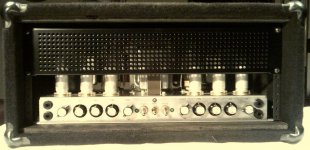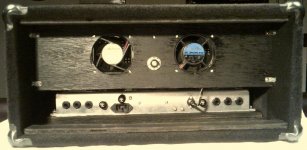A very long time coming, but I recently finished my Stereo Guitar Amp build. It will be evaluated at rehearsals for a while before using it on show dates.
The chassis is .080 aluminum with welded seams. 17 by 8 inch surface and 2 inch deep, plus bottom plate. No apparent flexing in spite of considerable weight of the iron.
All valve sockets are ceramic with gold plated pins. The layout was a challenge and calculated with a mock-up of the major components. Considerations made of transformers relative to one another and attempted to keep the first stage preamp as far away as possible.
All input and output jacks are isolated from the chassis. A star ground scheme was employed throughout. The main circulating currents of the power supply are kept within that loop and one tie to the star. It is a "common" power supply to each channel with appropriate decoupling.
A separate small transformer underneath, circuits isolated from chassis, feeds TO-220 case regulators for 12V fans and the 5V LED supplies.
Each channel is identical with three ECC83/12AX7 and PP EL34. The first stages are older Mullard, the others are older Sylvania. Outputs are Winged C SED. Currently I have "used tires" SED output valves for initial testing purposes. Saving the new (expensive) ones after I am satisfied with the amp's operation.
All iron is from Magnetic Components purchased from Triode. I had consulted with an engineer from Magnetic Components before ordering. His recommendation of the "upgrade" power transformer was appreciated since I was at the limits on heater current of the regular "100 watt" initial selection I made. Winged C EL34 has a slightly higher heater current requirement...
Each dual triode has a separate star connection, plus each output section likewise. The common of the output transformers has the negative feedback to the long tail and is star connected at that dual triode each side. I have separate output jacks for the 4, 8 and 16 ohm connections.
I initially tested the amp after finishing the power supply and one channel. I had the dreaded screech, and quickly realized I had the output plate leads inadvertently reversed. After reversing the leads all was well.
I was very pleased to find almost no gain hiss, no hum, noises or oscillations even with both gains wide open, no input jack connections.
Power out for each channel is right at 50 watts at threshold of clip into 8 ohm load resistors. Output plates at 490 volts idle, and according to the one ohm cathode resistors, each valve is currently running at about 30 or so mA, K current. O'Scope waveform looks nice, minimal crossover distortion at this bias setting.
The circuit is similar to the “not well liked” Marshall 4140, and since I will be feeding the inputs from a pedal board into some vintage rack mount devices, then to the amp - I left out the first stage “boost” cathode cap.
Overall, I am pretty happy how this turned out and looking forward to burn-in testing at rehearsals and eventual live shows.
Deric
The chassis is .080 aluminum with welded seams. 17 by 8 inch surface and 2 inch deep, plus bottom plate. No apparent flexing in spite of considerable weight of the iron.
All valve sockets are ceramic with gold plated pins. The layout was a challenge and calculated with a mock-up of the major components. Considerations made of transformers relative to one another and attempted to keep the first stage preamp as far away as possible.
All input and output jacks are isolated from the chassis. A star ground scheme was employed throughout. The main circulating currents of the power supply are kept within that loop and one tie to the star. It is a "common" power supply to each channel with appropriate decoupling.
A separate small transformer underneath, circuits isolated from chassis, feeds TO-220 case regulators for 12V fans and the 5V LED supplies.
Each channel is identical with three ECC83/12AX7 and PP EL34. The first stages are older Mullard, the others are older Sylvania. Outputs are Winged C SED. Currently I have "used tires" SED output valves for initial testing purposes. Saving the new (expensive) ones after I am satisfied with the amp's operation.
All iron is from Magnetic Components purchased from Triode. I had consulted with an engineer from Magnetic Components before ordering. His recommendation of the "upgrade" power transformer was appreciated since I was at the limits on heater current of the regular "100 watt" initial selection I made. Winged C EL34 has a slightly higher heater current requirement...
Each dual triode has a separate star connection, plus each output section likewise. The common of the output transformers has the negative feedback to the long tail and is star connected at that dual triode each side. I have separate output jacks for the 4, 8 and 16 ohm connections.
I initially tested the amp after finishing the power supply and one channel. I had the dreaded screech, and quickly realized I had the output plate leads inadvertently reversed. After reversing the leads all was well.
I was very pleased to find almost no gain hiss, no hum, noises or oscillations even with both gains wide open, no input jack connections.
Power out for each channel is right at 50 watts at threshold of clip into 8 ohm load resistors. Output plates at 490 volts idle, and according to the one ohm cathode resistors, each valve is currently running at about 30 or so mA, K current. O'Scope waveform looks nice, minimal crossover distortion at this bias setting.
The circuit is similar to the “not well liked” Marshall 4140, and since I will be feeding the inputs from a pedal board into some vintage rack mount devices, then to the amp - I left out the first stage “boost” cathode cap.
Overall, I am pretty happy how this turned out and looking forward to burn-in testing at rehearsals and eventual live shows.
Deric
Attachments
Last edited:
Very impressive build! Very envious of you.
I think the only thing I don't like is running the 12V fans at 12V. I would run them at 9V or 5V to be quieter.
I think the only thing I don't like is running the 12V fans at 12V. I would run them at 9V or 5V to be quieter.
Very impressive build! Very envious of you.
I think the only thing I don't like is running the 12V fans at 12V. I would run them at 9V or 5V to be quieter.
Well thank you very much sir. I am glad you like it. I had seen in my email there was a response to this thread, so before I get back to things around here, thought I would post.
As far as the fans - I know what you mean about fan noise. There is a speed control on the back panel in between the fans. I can adjust the fans to be very quiet if needed for like studio recording work.
And for live shows especially like outdoors in the Summer, I will probably let them run wide open. My group is primarily 80's album oriented rock (not metal) and we are not so quiet - haha. Not stupid loud, but we are not a lounge act.
Thank you again Leadbelly
Deric
Beautiful amp.
And thank you sir.
I am often on the forum and see your contributions all the time.
You are very experienced and knowledgeable.
I much respect you.
Individuals like you and so many others on here - make an awesome place for people around the world to share and learn together.
There are people brand new to all of this building and fixing and playing with electronics. I started radio repair at age 12, and just keep learning more all the time.
Electronics (especially the magic of valves for me) is a vast and fascinating pursuit.
Carry on
Deric
I also want to build a stereo amp.
Why did you decide to do it? What advantages are there for you?
What unique solutions did you have to come up with? You said the power supplies and grounds are decoupled?
Why did you decide to do it? What advantages are there for you?
What unique solutions did you have to come up with? You said the power supplies and grounds are decoupled?
I also want to build a stereo amp.
Why did you decide to do it? What advantages are there for you?
What unique solutions did you have to come up with? You said the power supplies and grounds are decoupled?
Greetings
Very good questions and I will do my best to answer them. This might be a short book - haha.
I had wanted to build a stereo amp for a very long time and decided to finally get with the program and just do it. The primary reason was for my personal enjoyment while performing on stage, and any recording I do, I would have the ability to end up with the full effect of some devices in my guitar rack - for example my Scholz Rockman 1/2 rack chorus (stereo out). Boston has always been one of my favorite artists, among many in the AOR genre. Tom Scholz combined his vast abilities in electronics with his musical talents to end up with some awesome sounds...
Some things to remember in "stereo" stage amp applications - one is when you are mic'ed, not only will it require 2 mics on my 4-12 cab into the FOH and along with that - is many times a sound rig will be a "mono" FOH output. Of course it will not be stereo in that situation and when combining a stereo feed into two channels of FOH, the result will be "mono" with an obvious reduction in the actual sound image I personally have on stage...
The guitar rig I currently use is largely unchanged from the early 80's when I first started in bands after high school. So that "combined" sound has been coming out mono all these years and I have liked it a lot and no complaints from any audience I remember. haha
My 4-12 cab is vintage Marshall, slant top, with the original Green Back 25W Celestion drivers. For me, I have always preferred the sound of a closed back cab. My 4-12, I opened it to convert to stereo by adding a second input jack and each side is 8 ohm plus I added a small switch in the upper part of a cab handle to go stereo/mono if I need it that way - and ends up a 4 ohm mono.
If I am using a regular guitar amp like my current Marshall, I will use the mono cab setting, or if I end up with two 4-12 (each used mono) cabs, then run them as a larger stereo rig.
My small pedal board feed to the rack devices is mono and I still have get the rack into my shop and determine a re-connect to have stereo out capability - and mono out if needed...
Unique solutions ? Regarding the amp itself, I spent considerable time deciding on the overall design of course. I wanted it to fit in a standard "rack" size case. I also researched many web sites on grounding schemes. I have been building and repairing electronics since Jr. High School. That was a few years ago - haha
I decided on a star ground type circuitry. To delve into every aspect of that would be beyond a single forum response. In my amp like I had stated in my "write up", each section has its own "return" to a single point, firmly bonded to the chassis. The incoming AC has its own proximate earth chassis connection.
I was attempting to avoid chassis circuit ground currents going everywhere and minimize hum potential (hopefully). It has ended up working out even better than I figured. A happy thing.
The decoupling is necessary between various stages like in any amp. And I do use a "common" power supply. The dual triodes each have a "local" electrolytic to common and each dual triode circuitry has its own star point that is then ran to the single chassis star bond. The opposite polarity of the signal in each dual triode is working fine returning through that individual common return. Avoiding "common" return current flow affecting other stages, is the goal of this star scheme.
One item of importance is in the HT bridge rectifier/main filters is the significant recharge circulating currents, remain within those few components but of course needs the connection to the star ground chassis bond point.
This has been a longer response but I wanted to address your questions best I could without getting too deep.
I will close at this point by saying I was not seeking or needing to have a high number dB R-L separation like what would be desired in a hi-fi stereo amp. My converted 4-12 cab is a common space inside between the drivers anyway. But this set up has already been initially tested and certainly is separated sufficiently for my use.
Hope this helped with your questions. And best of luck on what you decide to build.
Carry on
Deric
- Status
- Not open for further replies.
- Home
- Live Sound
- Instruments and Amps
- Stereo Valve Guitar Amp build

